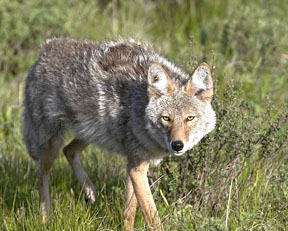Deadly run-in with coyote prompts new solutions

COUNCILMAN REPORT by Tom LaBonge.
Each day as Councilmember of District Four, I encounter new challenges that must be met in order to help and protect communities in the city of Los Angeles. This week after a tragic and deadly run-in between a dog and a coyote, I asked myself, what exactly could be done? Through the many years of being a Silverlake resident, I too have encountered coyotes and cannot help but notice that not only are our pets in danger, but our loved ones as well.
As most of you already know, the terrible incident that occurred in Hancock Park, about a half a block from Wilshire Blvd., is not the only recent encounter that has happened in this community or throughout CD4 itself. I would like to first take this time to express my deepest condolences to the family who is mourning the loss of their beloved dog, Jack.
Every morning when I hike in Griffith Park or as residents go on walks within their neighborhoods, we see coyotes in their natural habitat. Predators such as coyotes have adapted to human presence and behavior. Our initial instincts tell us to not take any action at all or run away. Coyotes have no reason to fear humans and therefore become bolder in behavior. Unfortunately, it’s been a dry year and these animals have come further south where there’s a lot of open space and have been recently attracted to our neighborhoods.
Whether a predatory wildlife incident happens in the Wilshire Country Club or the beautiful homes in Hancock Park or Windsor Square, this is a serious problem and something must be done. As Councilmember, I will do whatever I can to help raise awareness and let my constituents know that I am working to improve this situation.
With every problem, there are always several steps to resolve an issue. My first step is to talk to our Director of Animal Services and see if there is a strategy we can come up with to help mitigate this problem. In joint efforts with Animal Services, we will work together to try and find ways to protect our communities.
One of the issues the city comes up against is, it does not own wildlife, nor does it have the authority to move or remove wildlife, as dictated by both the state and federal governments. Los Angeles is still wild in many respects and our neighborhoods are also neighborhoods belonging to coyotes and other wildlife. However, this does not mean there are not many ways to protect one’s family and pets and to keep our loved ones safe.
One of the biggest things I’ve taken away from the information about coyotes is the importance of deterring and scaring them away, particularly if you have your pet with you when you encounter them. As constituents contact my office and raise their concerns, I provide them with a document that includes extensive information on how to deal with wildlife and coyotes within our communities. The document includes information from links to wildlife deterrents, scare tactics and suggestions on property alteration to reduce negative encounters with wildlife.
Today, what’s most important is new education on what to do now. This means, we as a community must be a part of the solution in a different way.
Methods on how to curb coyote attacks from city officials

COYOTES are wild animals and should be treated cautiously.
Small pets are in danger of being eaten by coyotes as the predators seek food and water along the streets of Hancock Park. Several pets already have been killed by the animals.
Greg Randall, wildlife specialist with the city Dept. of Animal Services, and Councilman Tom LaBonge are passing along ways to prevent attacks.
Always walk your dog on a leash and stay close to high pedestrian traffic areas.
Keep your pets indoors or secured in an outdoor kennel. Environmental factors can affect the time a coyote may appear.
If your yard does not have a fence, use a leash while on your property to keep your pet close to you. You may carry something with you for protection such as an air horn, whistle, walking stick or cane.
Confine small animals and birds that you cannot keep indoors to covered enclosures constructed of a heavy gauge wire mesh. Coyotes can break through chicken wire.
Put all trash bags inside the trash cans and keep all outdoor trash can lids securely fastened to the containers. Place trash bins inside sheds, garages or other enclosed structures.
Pick fruit from trees as soon as they ripen and pick up all fallen fruit. Cut low hanging branches to avoid the coyote feeding from trees. Trim ground-level shrubbery. Vegetable gardens should be protected within heavy-duty garden fences or enclosed by a greenhouse. Check with your local plant nursery to see what deterrent products are available, or you may find some items online.
Keep your property well lit at night.
Close off crawl spaces under porches, decks and sheds. Coyotes use such areas for resting and raising young.
Share this information with your neighbors. Your efforts may be futile if someone is providing food or shelter for coyotes. Remember this is a neighborhood effort.
Do not feed wild animals. It is illegal to feed predatory wildlife in the City of Los Angeles. (L.A.M.C. Sec. 53.06.5)
Do not leave pet food or water bowls outside if your companion animal is not outdoors. Local law requires that food and water be available to your companion animal when it is kept outside. However, bring in the dishes when your pet is inside.
Do not allow pets to roam from home.
Do not set your trash out until the day of pickup to reduce attracting predators in the middle of the night.
Coyotes are wild animals and should be treated as such. Never leave small children unattended.
Do not throw food into an open compost pile.
Deterrents and scare tactics include banging pans, blowing an air horn or whistle, using a bullhorn, waiving an open umbrella, raising your arms above your head and stomping your feet while shouting at the animal, or using a pressure water sprayer.
Spray a little ammonia in your trash can several times a week to cut the odor of food.
Place mothballs or mothball cakes in areas where coyotes sleep or hang out to deter them from staying.
Motion-activated devices such as lights, strobe lights and sprinklers can be useful.
Alternate the deterrents to prevent the coyote from getting used to one method.
For further information, contact the department’s Wildlife Division at www.laanimalservices.com.
Category: News


